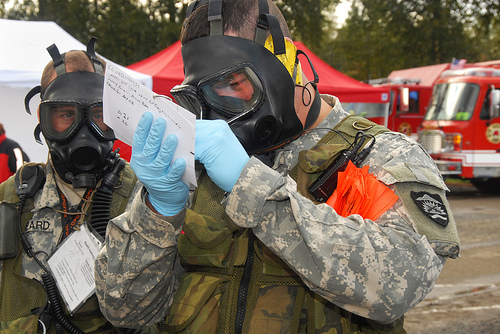When Ricin Exposure Happens, It's No Accident
11/03/2011 -The potential for a person to encounter ricin accidentally is so rare that the almost any cases of ricin illness would be considered the result of an attack, according to the U.S. Department of Health and Human Services (HHS).
Ricin, a biological toxin created from the waste leftover from processing castor beans that stops cells from making the proteins they need to survive, can be made into a powder that can be aerosolized. Pellets of ricin or ricin dissolved in a liquid can be ingested or injected into a person’s body.
Authorities in Georgia on Tuesday arrested four members of a militia group that were planning multiple bombings and a biological attack. Over the course of several meetings that were under surveillance by the FBI, the four men -- Frederick Thomas, 73, Dan Roberts, 67, Ray H. Adams, 65, and Samuel J. Crump, 68, discussed various attacks, including the use of explosives to target federal buildings. The group was also acquiring the means to make ricin and looking for a way todisperse the toxin while driving down the highway, the Los Angeles Times reported.
Ricin is lethal in small doses, but it's not clear how effective it the milita's plan would actually be. In 1978, an amount of ricin “the size of a pin head” was used to kill a Bulgarian journalist living in exile in London, however, scientists don’t know exactly how much ricin would be needed in an aerosol release to cause mass casualties -- nor do they know how long it would survive in the environment, according to HHS.
When it comes to ricin detection, “Almost any ricin illness would be considered an attack, since accidental ricin poisoning is extremely unlikely,” according to aguide on terrorism and public health emergenciescreated by HHS in 2005. “Evidence of an attack would be numerous cases of illness by people who have been in the same location or attended the same event.” Unlike anthrax, which commonlyinfects wild animals and still exists in nature along rural cattle trails in the United States and Canada, a person isn’t going to come into contact with ricin in the environment.
“It would take a deliberate act to make ricin and use it to poison people,” according to aCDC fact sheet, although the ingestion of castor beans could cause sickness related to ricin poisoning.
Until recently, there wasn’t a way to test human samples for ricin exposure. Doctors could only track the symptoms –fever, cough, difficulty breathing, organ failure, and check for fluid build-up in a patient’s lungs. If ricin is administered by injection, it immediately kills the muscles and lymph nodes around the injection site. Total organ failure and death usually occur within four days.
The CDC has developed a urine test that can measure ricinine, a marker of ricin exposure and there are several methods for testing suspicious substances. The U.S. Postal Service uses sensors to check mail for biochemicals like anthrax and ricin, for example.
While one expert told the Washington Post thatchances the men could have pulled off a large scale ricin attack were slim, another expert said what used to take three weeks in a lab can now be done by a “relatively unsophisticated technician.”
In the 40s, the U.S. military experimented with using ricin as a possible warfare agent. It has possibly been used as a warfare agent in Iraq and more recently by terrorist organizations, according to the CDC.
